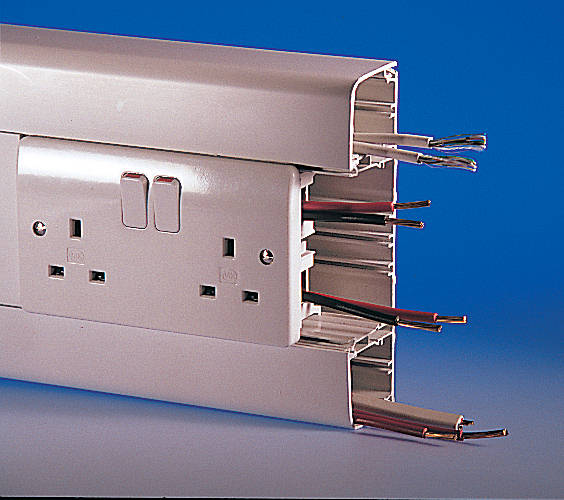When I bought my first house (Victorian) I had it completely rewired, then redecorated each room. As all lighting wiring had to be put in chased conduits I had no option but to remove the wallpaper from each room afterwards - and in most cases found most of the plaster came off too, resulting in a huge mess, huge expense of replastering and costing me lots of time that I hadn't envisaged.
I've just bought a new house. Again Victorian. This one has rather nice wallpaper in good condition in every room which I'd like to retain, especially knowing that (i) it's hard to remove and (ii) removing it will doubtless bring the plaster down with it resulting in yet more pain. And I just haven't got the budget or the time to totally redecorate the house before moving in.
But the electrics look like they just came out of a time warp - one single socket (mounted proud of the wall) in each room just above the skirting, lights suspended from yellowing cables in the ceilings and yellowing light switches. I've not had it inspected yet but I strongly suspect it's going to need some rewiring.
OK so the question - are there any shortcuts I can take to get the house rewired without affecting the wallpaper or the integrity of the plaster? Getting up floorboards isn't a problem - the house will be empty for a few weeks before I move in during which time I'm planning to sand and stain all the floors (but once that's done I don't want to have to get them up again). Here's my thoughts on rewiring:
(i) run all cables that go between floors along existing vertical conduits that are fairly innocuous and are near the front door for carrying the central heating pipes;
(ii) avoid the need to wreck the wallpaper and plaster by carefully cutting out holes for double sockets in the position of existing sockets, and adding the many new sockets I would need just above skirting board, with cabling behind skirting board. Is it possible to chisel out just enough plaster to allow a socket to be recessed without damaging the surrounding plaster/wallpaper?
(iii) is it possible to make some use of the existing light switch wires, as I suspect they won't be conduited behind the plaster so pulling new wire through isn't going to work? For instance, could they be connected to a low voltage circuit that controls the light fittings? I've also read a few overseas forum posts about fitting wall switch boxes that aren't connected to the mains as they have a battery and wireless transmitter to turn the lights on - but I can't find any links to any UK distributors and don't know if they would be aesthetically in keeping with a "period" house. I'm considering having traditional candle bulb style LED lights throughout the house - big initial expense but cheap running costs and no more blown bulbs, if that makes any difference.
Thanks for any advice.
I've just bought a new house. Again Victorian. This one has rather nice wallpaper in good condition in every room which I'd like to retain, especially knowing that (i) it's hard to remove and (ii) removing it will doubtless bring the plaster down with it resulting in yet more pain. And I just haven't got the budget or the time to totally redecorate the house before moving in.
But the electrics look like they just came out of a time warp - one single socket (mounted proud of the wall) in each room just above the skirting, lights suspended from yellowing cables in the ceilings and yellowing light switches. I've not had it inspected yet but I strongly suspect it's going to need some rewiring.
OK so the question - are there any shortcuts I can take to get the house rewired without affecting the wallpaper or the integrity of the plaster? Getting up floorboards isn't a problem - the house will be empty for a few weeks before I move in during which time I'm planning to sand and stain all the floors (but once that's done I don't want to have to get them up again). Here's my thoughts on rewiring:
(i) run all cables that go between floors along existing vertical conduits that are fairly innocuous and are near the front door for carrying the central heating pipes;
(ii) avoid the need to wreck the wallpaper and plaster by carefully cutting out holes for double sockets in the position of existing sockets, and adding the many new sockets I would need just above skirting board, with cabling behind skirting board. Is it possible to chisel out just enough plaster to allow a socket to be recessed without damaging the surrounding plaster/wallpaper?
(iii) is it possible to make some use of the existing light switch wires, as I suspect they won't be conduited behind the plaster so pulling new wire through isn't going to work? For instance, could they be connected to a low voltage circuit that controls the light fittings? I've also read a few overseas forum posts about fitting wall switch boxes that aren't connected to the mains as they have a battery and wireless transmitter to turn the lights on - but I can't find any links to any UK distributors and don't know if they would be aesthetically in keeping with a "period" house. I'm considering having traditional candle bulb style LED lights throughout the house - big initial expense but cheap running costs and no more blown bulbs, if that makes any difference.
Thanks for any advice.





